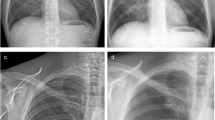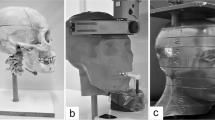Abstract
The image quality of dual-reading computed radiography and dose-reduced direct radiography of the chest was compared in a clinical setting. The study group consisted of 50 patients that underwent three posteroanterior chest radiographs within minutes, one image obtained with a dual read-out computed radiography system (CR; Fuji 5501) at regular dose and two images with a flat panel direct detector unit (DR; Diagnost, Philips). The DR images were obtained with the same and with 50% of the dose used for the CR images. Images were evaluated in a blinded side-by-side comparison. Eight radiologists ranked the visually perceivable difference in image quality using a three-point scale. Then, three radiologists scored the visibility of anatomic landmarks in low and high attenuation areas and image noise. Statistical analysis was based on Friedman tests and Wilcoxon rank sum tests at a significance level of P<0.05. DR was judged superior to CR for the delineation of structures in high attenuation areas of the mediastinum even when obtained with 50% less dose (P<0.001). The visibility of most pulmonary structures was judged equivalent with both techniques, regardless of acquisition dose and speed level. Scores for image noise were lower for DR compared with CR, with the exception of DR obtained at a reduced dose. Thus, in this clinical preference study, DR was equivalent or even superior to the most modern dual read-out CR, even when obtained with 50% dose. A further dose reduction does not appear to be feasible for DR without significant loss of image quality.

Similar content being viewed by others
References
Rong XJ, Shaw CC, Liu X, Lemacks MR, Thompson SK (2001) Comparison of an amorphous silicon/caesium iodide flat-panel digital chest radiography system with screen/film and computed radiography systems—a contrast-detail phantom study. Med Phys 28:2328–2335
Hennigs SP, Garmer M, Jaeger HJ, Classen R, Jacobs A, Gissler HM, Christmann A, Mathias K (2001) Digital chest radiography with a large-area flat-panel silicon X-ray detector: clinical comparison with conventional radiography. Eur Radiol 11:1688–1696
Chotas HG, Ravin CE (2001) Digital chest radiography with a solid-state flat-panel X-ray detector: contrast-detail evaluation with processed images printed on film hard copy. Radiology 218:679–682
Strotzer M, Gmeinwieser JK, Volk M, Frund R, Seitz J, Feuerbach S (1998) Detection of simulated chest lesions with normal and reduced radiation dose: comparison of conventional screen-film radiography and a flat-panel X-ray detector based on amorphous silicon. Invest Radiol 33:98–103
Peer S, Neitzel U, Giacomuzzi SM, Peer R, Gassner E, Steingruber I, Jaschke W (2001) Comparison of low-contrast detail perception on storage phosphor radiographs and digital flat panel detector images. IEEE Trans Med Imaging 20:239–242
Strotzer M, Volk M, Frund R, Hamer O, Zorger N, Feuerbach S (2002) Routine chest radiography using a flat-panel detector: image quality at standard detector dose and 33% dose reduction. AJR Am J Roentgenol 178:169–171
Fink C, Hallscheidt PJ, Noeldge G, Kampschulte A, Radeleff B, Hosch WP, Kauffmann GW, Hansmann J (2002) Clinical comparative study with a large-area amorphous silicon flat-panel detector: image quality and visibility of anatomic structures on chest radiography. AJR Am J Roentgenol 178:481–486
Hosch WP, Fink C, Radeleff B, Kampschulte a A, Kauffmann GW, Hansmann J (2002) Radiation dose reduction in chest radiography using a flat-panel amorphous silicon detector. Clin Radiol 57:902–907
Herrmann A, Bonel H, Stabler A, Kulinna C, Glaser C, Holzknecht N, Geiger B, Schatzl M, Reiser F (2002) Chest imaging with flat-panel detector at low and standard doses: comparison with storage phosphor technology in normal patients. Eur Radiol 12:385–390
Shaw CC, Wang TP, Breitenstein DS, Gur D (1997) Improvement of signal-to-noise and contrast-to-noise ratios in dual-screen computed radiography. Med Phys 24:1293–1302
Uffmann M, Prokop M, Eisenhuber E, Fuchsjäger M, Weber M, Schaefer-Prokop C (2005) Computed radiography and direct radiography: influence of acquisition dose on the detection of simulated lung lesions. Invest Radiol 40:249–256
Sund P, Bath M, Kheddache S, Mansson LG (2004) Comparison of visual grading analysis and determination of detective quantum efficiency for evaluating system performance in digital chest radiography. Eur Radiol 14:48–58
Volk M, Hamer OW, Feuerbach S, Strotzer M (2004) Dose reduction in skeletal and chest radiography using a large-area flat-panel detector based on amorphous silicon and thallium-doped cesium iodide: technical background, basic image quality parameters, and review of the literature. Eur Radiol 14:827–834
Author information
Authors and Affiliations
Corresponding author
Rights and permissions
About this article
Cite this article
Gruber, M., Uffmann, M., Weber, M. et al. Direct detector radiography versus dual reading computed radiography: feasibility of dose reduction in chest radiography. Eur Radiol 16, 1544–1550 (2006). https://doi.org/10.1007/s00330-005-0077-1
Received:
Revised:
Accepted:
Published:
Issue Date:
DOI: https://doi.org/10.1007/s00330-005-0077-1




